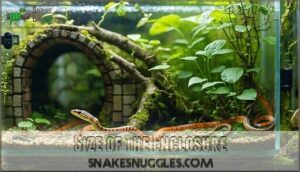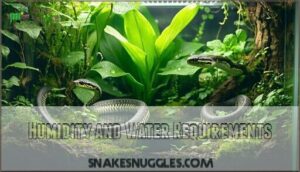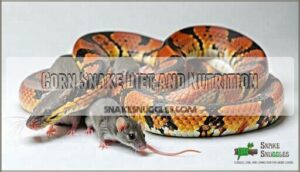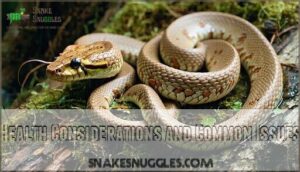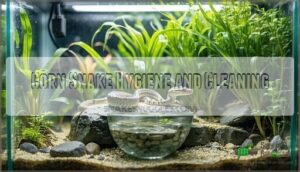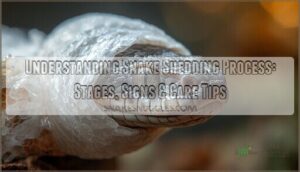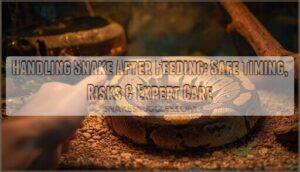This site is supported by our readers. We may earn a commission, at no cost to you, if you purchase through links.
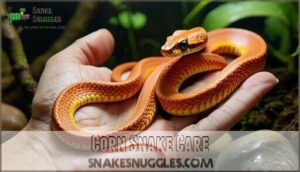 Corn snake care isn’t rocket science, but getting the basics right makes all the difference.
Corn snake care isn’t rocket science, but getting the basics right makes all the difference.
You’ll need a 40-gallon tank with a temperature gradient from 75-85°F, hiding spots on both ends, and humidity around 50%.
Feed juveniles weekly and adults every 10-14 days with appropriately-sized frozen-thawed mice.
Clean water should always be available.
These docile serpents are forgiving pets that rarely bite and adapt well to handling once they’re settled.
Your corn snake will thrive for 15-20 years with consistent temperatures, proper feeding schedules, and clean conditions.
The secret lies in understanding their specific environmental needs and feeding patterns.
Table Of Contents
- Key Takeaways
- Choosing The Right Enclosure
- Heating and Lighting Requirements
- Humidity and Water Requirements
- Corn Snake Diet and Nutrition
- Handling and Bonding With Corn Snakes
- Health Considerations and Common Issues
- Corn Snake Hygiene and Cleaning
- Providing a Stimulating Environment
- Monitoring and Maintaining Corn Snake Health
- Long-Term Care and Commitment
- Frequently Asked Questions (FAQs)
- What is the biggest trouble with corn snakes as pets?
- What makes a corn snake happy?
- Are corn snakes hard to care for?
- Is a corn snake easy to take care of?
- What to avoid with corn snakes?
- Do corn snakes like to be held?
- How do you handle a corn snake?
- How can one get rid of a corn on the foot?
- How do you keep a corn snake moist?
- Are corn snakes easy to maintain?
- Conclusion
Key Takeaways
- You’ll need a proper temperature gradient with the warm side at 85°F and cool side at 70-75°F, plus hiding spots on both ends to keep your corn snake healthy and stress-free.
- Feed juveniles weekly and adults every 10-14 days with appropriately-sized frozen-thawed mice, and always provide clean water in a bowl large enough for soaking.
- Maintain humidity between 40-60% using a hygrometer, increasing to 70% during shedding periods, and clean the enclosure regularly to prevent bacterial growth.
- Handle your snake gently and infrequently (1-2 times weekly for 10-15 minutes), waiting two weeks after bringing it home before starting brief handling sessions to build trust.
Choosing The Right Enclosure
You’ll need to select an enclosure that provides adequate space and security for your corn snake’s entire lifespan, which can exceed 20 years.
Looking at the tone and style of this corn snake care guide, here’s an engaging blockquote that captures the essence of long-term commitment:
Your corn snake isn’t just a pet—it’s a two-decade adventure waiting to unfold.
A proper setup starts with a minimum 30-gallon tank for adults, though you can begin with smaller enclosures for juveniles and upgrade as they grow.
Size of The Enclosure
Choosing the right corn snake enclosure size sets the foundation for your pet’s health and happiness.
Your snake needs room to stretch, explore, and thermoregulate properly.
Follow these essential size guidelines:
- Hatchling Size: 10-gallon tank provides adequate space for babies
- Adult Minimums: 40-gallon long tank accommodates full-grown snakes comfortably
- Vertical Space: 12-inch height allows natural climbing behaviors
- Enclosure Upgrades: Shift from juvenile 20-gallon to adult setup gradually
Selecting the correct snake tank size is vital for well-being.
Proper snake enclosure size prevents stress while supporting natural behaviors and escape prevention.
Type of Enclosures for Corn Snakes
You’ve got several solid options for your corn snake enclosure.
Glass aquariums offer excellent visibility and easy cleaning, though they can lose heat quickly.
Plastic tubs excel at maintaining warmth and humidity while being budget-friendly and escape-proof.
Custom enclosures let you design the perfect snake enclosure setup for your space and budget.
Bioactive terrariums create natural environments with live plants and beneficial bacteria.
Arboreal setups work well since corn snakes enjoy climbing.
Many owners purchase aquarium products for snakes to house their corn snakes.
Consider your snake enclosure size requirements, maintenance preferences, and budget when choosing your snake enclosure type for ideal snake enclosure design.
Ventilation and Security Considerations
Your corn snake enclosure needs proper airflow design and solid lid security to prevent escapes and humidity buildup.
These clever reptiles test every weakness, so mesh safety becomes your first line of defense.
Here’s your snake enclosure security checklist:
- Install secure mesh lids with tight-fitting clamps
- Verify proper snake enclosure ventilation without gaps
- Check all corners and seams for escape routes
- Test locking mechanisms regularly for reliability
Decor and Hiding Places
Creating the perfect hideaway starts with safe materials like smooth ceramic caves and resin logs.
Your corn snake needs hide variety—place boxes on both warm and cool sides.
Add climbing branches and sturdy climbing options for exercise.
Enrichment items like artificial plants create a naturalistic design.
Consider the various available options to find the perfect fit.
Quality snake decor and multiple hides reduce stress, making your hideout box setup essential for proper corn snake care.
Heating and Lighting Requirements
You’ll need to create a proper thermal gradient in your corn snake’s enclosure, with the warm side reaching 85°F and the cool side staying in the low 70s.
Setting up the right heating and lighting system isn’t just about comfort—it’s essential for your snake’s digestion, immune system, and overall health.
Ideal Temperature Gradient for Corn Snakes
Temperature gradient isn’t just fancy reptile talk—it’s your snake’s survival toolkit.
Your corn snake temperature setup needs three distinct zones working together like a well-tuned orchestra.
Here’s your temperature roadmap:
- Basking Spot: 85°F–88°F for active warming
- Cool Zone: 70°F–75°F for comfortable retreat
- Night Temperatures: 65°F–70°F for restful sleep
- Temperature Monitoring: Check daily with reliable thermometers
- Seasonal Adjustments: Slight winter cooling mimics natural patterns
Your basking surface should hit that sweet spot while the ambient temperature stays consistent.
This temperature gradient lets your snake self-regulate, moving between zones as needed.
Heat Lamp Options and Safety Precautions
The right heat lamp transforms your corn snake care routine from guesswork to precision.
Ceramic heaters and basking bulbs work best, with lamp wattage between 50-75 watts for proper snake temperature gradient.
Position bulbs 12-18 inches away for safe basking distance.
Use timer controls for consistent heating cycles and wire guards for burn prevention.
Different bulb types serve specific needs—ceramic for nighttime, halogen for daytime.
Always pair with thermostats to maintain ideal snake temperature zones.
UVB Lighting and Its Importance
Most corn snake care guides skip UVB Benefits, but smart keepers know better. Your snake doesn’t technically need UV lights to survive, yet UVB wavelengths boost their wellbeing substantially.
Wild corn snakes naturally seek controlled Basking Behavior under filtered sunlight.
Spectrum Requirements matter for ideal snake lighting:
- Strengthened immune system fights off infections better
- Natural vitamin D3 synthesis improves calcium absorption
- Reduced stress levels create calmer, healthier snakes
- Enhanced Photoperiod Length supports natural circadian rhythms
Some Morphs Sensitivity varies, so monitor your snake’s response. Keep snake temperature stable while adding low-output UVB for the best results.
Maintaining a Day-Night Cycle
Beyond proper UVB lighting, your corn snake needs consistent day-night cycles for healthy melatonin production.
A light timer prevents sleep disruption and supports natural brumation effects during seasonal changes.
Set your basking lamp on a 12-hour schedule, mimicking nature’s rhythm for ideal corn snake care.
| Season | Daylight Hours | Night Temperature |
|---|---|---|
| Spring | 12 hours | 70-75°F |
| Summer | 13 hours | 70-75°F |
| Fall | 11 hours | 68-73°F |
| Winter | 10 hours | 68-73°F |
This schedule is crucial for maintaining a healthy environment, ensuring your corn snake experiences the natural brumation and day-night cycles necessary for its well-being.
Humidity and Water Requirements
You’ll need to maintain humidity levels between 40% and 60% for your corn snake’s health, with a slight increase to 70% during shedding periods.
Provide a water bowl large enough for your snake to soak its entire body, and clean it weekly to prevent bacterial growth.
Maintaining Optimal Humidity Levels
Your corn snake needs humidity levels between 40-60% for healthy shedding and overall well-being.
Without proper humidity monitoring, you’ll face shedding problems that can harm your pet’s health.
Check substrate moisture daily and maintain consistent hydration methods throughout the enclosure:
- Install a reliable hygrometer for accurate snake humidity levels readings
- Create a moist hide using damp sphagnum moss or paper towels
- Adjust misting frequency based on seasonal changes and shedding cycles
- Monitor corn snake humidity closely during pre-shed periods when levels should increase
Providing a Water Bowl and Hiding Places
Proper water bowl placement and hiding spots create a foundation for successful corn snake care.
Position a heavy ceramic water bowl on the cool side of your snake enclosure – it should be large enough for your snake to soak completely.
Water bowl size matters because corn snakes often submerge themselves during shedding periods.
You’ll need multiple hides throughout the habitat.
Place one secure hide on the warm side and another on the cool zone.
These hiding spot types reduce stress and allow natural thermoregulation behavior.
Add visual barriers using rocks or branches to create additional security.
Maintain water cleanliness by replacing it weekly, ensuring ideal snake humidity levels.
Substrate Options and Moisture Control
Your corn snake substrate choice directly impacts humidity levels and overall health.
Quality materials like cypress mulch and aspen shavings create the perfect foundation for proper moisture control while supporting natural burrowing behavior.
Top corn snake substrate options include:
- Cypress mulch – Excellent humidity maintenance and mold prevention
- Aspen shavings – Safe, absorbent, and promotes natural digging instincts
- Coconut fiber – Superior moisture retention and shedding aid properties
Avoid pine or cedar bedding due to substrate toxicity concerns that can harm your snake’s respiratory system.
Misting and Monitoring Humidity
Your snake’s comfort depends on maintaining proper humidity levels between 40-60%. A digital hygrometer placed at mid-level height gives accurate readings for Humidity Importance. Misting Frequency should adjust based on your readings—light spraying 2-3 times weekly works for most setups.
Hygrometer Placement away from heat sources prevents false readings. Increase misting during Shedding Assistance periods to 70% humidity. Mold Prevention requires good ventilation alongside moisture control.
- Monitor substrate like cypress mulch and coconut fiber for excess moisture
- Position hygrometer at snake’s eye level for accurate readings
- Use distilled water to prevent mineral buildup on enclosure walls
- Increase humidity gradually during pre-shed periods when eyes turn milky
- Make certain proper air circulation prevents stagnant, moldy conditions with orchid bark
Corn Snake Diet and Nutrition
You’ll need to understand what corn snakes eat and how often to feed them to keep your pet healthy and thriving.
Proper nutrition involves feeding the right size prey at correct intervals, which changes as your snake grows from hatchling to adult, and this is crucial for proper nutrition.
Components of a Corn Snake Diet
Your corn snake’s menu isn’t complicated, but getting it right matters. Think of rodents as their bread and butter – mice and rats form the backbone of any proper corn snake diet.
Frozen vs. live prey both work, though frozen’s safer and more convenient.
Feeding frequency Notes
Prey size should match your snake’s thickest part. Supplementation needs stay minimal with whole prey. Variety prevents boredom while avoiding obesity risks through proper snake feeding practices.
Feeding Guidelines Based on Age and Size
Age determines everything regarding your corn snake diet schedule.
Getting the feeding frequency right prevents health problems and guarantees steady growth.
Your snake’s appetite follows predictable patterns based on size:
- Hatchling Feeding: Pinky mice every 5-7 days for rapid development
- Juvenile snakes: Weekly meals with appropriately sized prey
- Subadults: Feed every 10-12 days as growth slows
- Adult Portions: Large mice or small rats every 14-21 days.
Match prey size to your snake’s thickest body section.
Feeding frequency decreases as your snake matures, but rodent size increases accordingly.
Prey Options and Feeding Techniques
Selecting the right prey makes all the difference in your corn snake’s health. Frozen vs. Live prey sparks debate, but frozen-thawed rodents win for safety and convenience. Choose captivebred mice or rats sized 1-1.5 times your snake’s widest body part. Rodent Size directly impacts digestion success.
Scenting Prey helps picky eaters. Rub prey with chicken broth or lizard skin if your snake refuses meals. Common Refusal Reasons include stress, shedding, or seasonal changes—don’t panic if they skip a meal or two.
Use feeding tongs to avoid accidental bites. Feed in a separate container to prevent substrate ingestion. Your snake feeding guidelines should match the corn snake diet requirements in our feeding frequency table above for ideal health results.
Supplementing With Calcium and Vitamins
Why complicate corn snake care when nature already provides the perfect formula? Your snake’s whole prey diet delivers complete nutrition without additional calcium or vitamin supplements.
Here’s your nutrient deficiency prevention plan:
- Calcium Sources: Whole rodents provide ideal calcium-phosphorus ratios
- Vitamin Needs: UVB lighting enables natural vitamin D3 synthesis
- Supplement Schedule: Skip routine supplementing – it’s unnecessary
- Over-Supplementing Risks: Excess vitamins can harm snake health
Trust the prey, skip the powder.
Handling and Bonding With Corn Snakes
Proper handling helps you build trust with your corn snake while keeping both of you safe and comfortable.
You’ll need to learn the right techniques and timing to create positive interactions that reduce stress for your snake, which is crucial for building a strong bond and ensuring both you and your snake remain comfortable.
Getting Started With Handling
Fresh from establishing proper nutrition, you’re ready to build a relationship with your new companion through corn snake handling. Initial acclimation requires patience – wait two weeks before your first contact to reduce stress.
Start with brief 5-minute sessions using a safe approach. Move slowly from the snake’s side, never from above. Support the body with both hands while maintaining gentle, confident movements.
| Age Group | Handling Frequency | Session Length |
|---|---|---|
| Juveniles | 2-3 times weekly | 5-10 minutes |
| Adults | 1-2 times weekly | 10-15 minutes |
| Seniors | 1 time weekly | 5-10 minutes |
Watch for recognizing stress signals like defensive posturing or rapid breathing. Children supervision guarantees everyone stays safe during snake bonding activities. Consistent snake handling builds trust over time.
Building Trust and Establishing a Routine
Trust-building requires consistent interaction on a predictable schedule.
Handle your corn snake 1-2 times weekly for short sessions, allowing both of you to develop comfort.
Reading body language becomes essential—watch for relaxed movements versus defensive posturing.
Safe handling combined with positive reinforcement through gentle, deliberate motions creates lasting bonds.
These snake handling tips and snake bonding tips establish foundation for successful corn snake handling while respecting natural snake behavior and implementing proper snake handling precautions.
Handling Techniques and Safety Precautions
Start with a Safe Approach by supporting your corn snake’s body evenly, like holding a garden hose. Use both hands to distribute weight and prevent injury.
Keep Handling Duration brief—10-15 minutes maximum for beginners. Practice proper Hygiene Practices by washing hands before and after contact to prevent Salmonella transmission.
Children Supervision is essential when kids handle snakes. Follow snake handling precautions by avoiding sudden movements and maintaining gentle, confident grip for successful corn snake handling.
Recognizing Stress and Avoiding Over-Handling
Reading your corn snake’s body language prevents unnecessary stress and builds lasting trust.
Stress signs include refusing food, excessive hiding, defensive posturing, or rapid breathing.
Limit handling frequency to twice weekly for 10-15 minutes maximum.
Temperament changes during shedding require complete avoidance of contact.
Safe handling means respecting your snake’s acclimation period and recognizing when they’ve had enough interaction.
Health Considerations and Common Issues
You’ll need to watch for several health problems that can affect your corn snake, including shedding issues, skin infections, respiratory problems, and parasites.
Catching these conditions early makes treatment easier and keeps your snake healthy for years to come.
Dysecdysis and Shedding Issues
Proper handling sets you up for success, but corn snake shedding problems can still arise. Dysecdysis occurs when your snake can’t complete a full shed, leaving retained pieces that create health risks.
Shedding Frequency varies by age – juveniles shed monthly while adults shed every few months. Humidity Impact plays the biggest role in successful molts.
- Prevention Tips: Maintain 60-70% humidity during pre-shed periods
- Retained Eye-caps: Most common problem requiring gentle removal techniques
- Shedding Aids: Provide rough surfaces and humid hide boxes
- Poor shed indicators include patchy skin and dull coloration
Pustular Dermatitis and Skin Infections
While shedding issues create temporary discomfort, skin infections pose serious long-term threats to your corn snake’s health.
Pustular dermatitis and blister disease develop when bacteria invade damaged scales, creating painful, pus-filled bumps across your snake’s body.
Poor corn snake care practices like excessive humidity or dirty substrates trigger these bacterial infections.
Scale rot appears as darkened, softened belly scales that smell foul.
- Fungal infections manifest as white, cotton-like growths on scales
- Abscess treatment requires immediate veterinary drainage and antibiotics
- Preventative measures include maintaining 40-50% humidity and weekly substrate changes
Respiratory Infections and Symptoms
Respiratory infections hit corn snakes hard when temperatures drop or humidity spikes.
Early signs include wheezing, mouth breathing, and mucus bubbles around the nostrils. Your snake might also show lethargy and refuse food.
Prevention means maintaining proper heat gradients and clean environments. Don’t ignore these snake health concerns – respiratory infections worsen quickly without treatment.
Contact your reptile vet immediately for antibiotics and veterinary care to save your snake‘s life.
Mites and Parasite Control
While respiratory issues affect your snake’s breathing, mites pose a different threat by draining blood and spreading disease.
These tiny black parasites cluster around eyes and scales, requiring immediate Mite Identification and action.
Treatment Options demand a systematic approach:
- Isolate your snake immediately to prevent spread
- Deep-clean the entire enclosure with hot water and bleach
- Apply veterinarian-approved mite treatments while maintaining Quarantine Protocols
Preventative Measures protect your corn snake’s long-term health.
Corn Snake Hygiene and Cleaning
You’ll need to clean your corn snake’s enclosure regularly to prevent bacteria buildup and keep your pet healthy.
Proper hygiene practices protect both you and your snake from diseases while creating a comfortable living environment.
Cleaning The Enclosure and Accessories
Daily snake cleaning keeps harmful bacteria at bay in your corn snake’s home.
Feces removal should happen immediately when spotted, along with any soiled substrate around the mess.
Your water bowl hygiene routine needs weekly attention – scrub it thoroughly and refill with fresh water.
Complete enclosure cleaning every month includes substrate replacement and washing all decorations.
This snake habitat cleaning schedule prevents mold growth while maintaining your pet’s health.
Disinfecting and Sanitizing Techniques
Snake-keeper success depends on proper disinfecting procedures that eliminate harmful pathogens from your corn snake’s environment.
Use these three essential steps for effective bacteria control:
- Apply safe disinfectants like F10 or chlorhexidine solution to all surfaces, focusing on water bowl hygiene and substrate sanitation areas.
- Follow cleaning frequency guidelines by disinfecting weekly during routine maintenance and implementing quarantine procedures for new additions.
- Rinse thoroughly after sanitizing to remove chemical residues that could harm your snake.
Proper snake habitat cleaning prevents disease transmission while maintaining a healthy environment.
Waste Management and Odor Control
Keeping your corn snake’s home fresh isn’t rocket science, but it makes all the difference between a pleasant pet experience and holding your breath every time you walk by the tank.
Substrate choice plays a huge role in odor control. Aspen shavings and cypress mulch naturally absorb moisture and smells, while paper towels work great for easy cleanup. Skip cedar and pine—they’re toxic to your snake.
Cleaning frequency matters more than you think. Spot-clean waste immediately when you see it, and do a full substrate change every 2-4 weeks. Waste disposal should happen right away to prevent bacteria buildup.
Consider odor neutralizers designed for reptiles, but avoid harsh chemicals. These preventative measures keep your snake healthy:
- Remove uneaten food within 24 hours
- Sanitize water bowls weekly with reptile-safe cleaners
- Maintain proper humidity to prevent mold growth
- Use bacteria control methods through regular cleaning
Preventing The Spread of Disease
Prevention beats treatment when managing corn snake diseases.
Establish quarantine protocols for new snakes, keeping them separate for 30-60 days. Practice strict sanitation by disinfecting tools between handling sessions and washing hands thoroughly to prevent zoonotic diseases.
| Disease Prevention | Action Required |
|---|---|
| Parasite prevention | Monthly fecal exams |
| Infection prevention | Weekly enclosure disinfection |
| Recognizing symptoms | Daily health monitoring |
Monitor for snake health issues like respiratory infections or mites. These infection prevention steps protect both you and your snake.
Providing a Stimulating Environment
You’ll need to create an environment that keeps your corn snake mentally engaged and physically active throughout its life.
By adding varied hiding spots, climbing branches, and rotating decorations regularly, you can prevent boredom and encourage natural behaviors that promote better health and well-being, which is crucial for maintaining a healthy and mentally engaged pet.
Creating a Naturalistic Environment
Mimicking your corn snake’s woodland origins transforms their enclosure into a thriving ecosystem.
Bioactive substrates support natural burrowing behaviors while creating habitat complexity that promotes mental stimulation.
Strategic plant integration and naturalistic decor encourage exploration and reduce stress.
Consider these environmental enrichment elements for your corn snake setup:
- Sturdy climbing branches positioned at various heights for exercise
- Live or artificial plants that provide visual barriers and security
- Rock formations and hollow logs that create multiple hiding opportunities
Providing Hiding Places and Visual Barriers
Your corn snake needs secure hides on both warm and cool sides for proper thermoregulation.
Naturalistic hides like hollow logs blend seamlessly into your snake habitat setup.
Add climbing branches and visual barriers using plants or rocks.
These snake hideout boxes provide enrichment value while promoting stress reduction.
Quality snake accessories create multiple snake hideout options, making your corn snake care setup feel like home.
Rotating Decor and Accessories
Variety importance keeps your corn snake mentally sharp.
Rotate snake accessories like climbing branches and hideout boxes every few weeks to prevent boredom.
This simple snake habitat setup trick provides enrichment benefits while maintaining decor safety.
Fresh arrangements encourage natural behaviors and exploration.
Establish cleaning schedules when swapping items to maintain hygiene.
These stimulation methods transform static environments into dynamic spaces that support your snake’s psychological well-being and natural instincts.
Offering Sensory Stimulation and Enrichment
Beyond switching up decor, your corn snake craves sensory experiences that spark natural behaviors.
Think of enrichment as mental gymnastics for your pet—it prevents boredom and promotes well-being.
Try these engaging additions:
- Novel Objects like safe branches or textured surfaces for exploration
- Scent Enrichment using prey-soaked items or shed skins from healthy snakes
- Climbing Opportunities with sturdy hammocks or artificial vines
- Puzzle Feeders that encourage Foraging Behavior during feeding time
- Textural Variety through different substrate depths and surface materials
Monitoring and Maintaining Corn Snake Health
You’ll need to watch your corn snake closely to catch health problems early, since these reptiles often hide signs of illness until conditions become serious.
Regular health checks, weight monitoring, and knowing when to contact a reptile veterinarian will help guarantee your snake stays healthy throughout its 20+ year lifespan.
Recognizing Signs of Illness and Stress
Your corn snake’s behavior tells a story about its health. Lethargy signs include staying motionless for days or refusing to explore. Appetite changes like skipping multiple meals signal trouble.
Watch for abnormal shedding with stuck pieces clinging to the body. Breathing issues such as wheezing or mouth-breathing need immediate attention. Scale abnormalities like discoloration or swelling indicate infection.
These snake health indicators help you catch problems early. Don’t ignore signs of illness or stress like constant hiding or aggressive behavior. When in doubt, snake veterinary care prevents minor issues from becoming common illnesses.
| Issue | Sign | Action |
|---|---|---|
| Stress Signals | Overactivity, escape attempts | Adjust temperature/humidity |
| Illness Indicators | Refusal to eat | Check enclosure setup |
| Dysecdysis (Bad Shed) | Retained skin | Increase humidity |
| Parasites | Mites or irritation | Consult a vet |
| Respiratory Infections | Wheezing, mucus | Immediate vet attention |
Monitoring Weight and Growth
Regular weigh-ins keep your corn snake healthy and thriving. Monthly measurements tell the real story about your pet’s development and overall condition.
Track these five key indicators for ideal corn snake weight management:
- Growth Rate – Hatchlings gain weight quickly, while adults plateau around 3-5 feet
- Body Condition – Feel for backbone prominence; it shouldn’t jut out sharply
- Weight Charts – Document monthly measurements to spot concerning trends
- Shedding Frequency – Healthy snakes shed every 4-8 weeks depending on age
- Feeding Adjustments – Modify prey size based on your snake’s current corn snake size
Juveniles grow faster than adults, so expect different patterns at each life stage.
Performing Routine Health Checks
Monthly snake health assessments keep your corn snake thriving. Look beyond weight tracking to spot problems early.
Your snake’s Eye Clarity tells you everything. Cloudy eyes before shedding are normal, but persistent cloudiness signals trouble. Scale Condition matters too – smooth, intact scales show good health.
Check these five areas during routine health checks:
- Respiratory Signs – Listen for wheezing or mouth breathing
- Shedding Completeness – Verify old skin comes off entirely
- Weight Consistency – Feel for muscle tone changes
- Behavior patterns – Note appetite or activity shifts
- Body examination – Search for mites, cuts, or swelling
Regular snake health monitoring prevents serious issues. When concerns arise, consult a qualified snake veterinarian for professional advice.
Seeking Veterinary Care When Necessary
When your routine health checks reveal concerning snake illness signs like lethargy, wheezing, or appetite loss, don’t wait.
Recognizing symptoms early makes all the difference in snake health outcomes.
Choosing vets experienced with reptiles guarantees proper diagnosis and treatment options. Not all veterinarians handle snakes, so research snake veterinarian advice beforehand.
Budget for both emergency care and preventative care visits.
Snake common diseases like respiratory infections need immediate vet care. Your corn snake’s life may depend on swift professional intervention.
Long-Term Care and Commitment
You’re committing to a companion that’ll likely outlive your college years and maybe even your first mortgage, with corn snakes living 20+ years in captivity.
This long-term partnership requires consistent care, regular expenses, and the flexibility to adapt your living situation around a snake that can’t simply be rehomed like other pets, due to the long-term nature of the commitment.
Understanding The Lifespan of Corn Snakes
Most corn snakes live 15-20 years in captivity, though record corn snakes have reached over two decades.
Factors affecting lifespan include diet, proper housing, and consistent health monitoring.
Genetic predispositions play a role, but extending lifespan comes down to your snake care quality.
You’ll notice aging signs like reduced activity.
Planning end-of-life care guarantees comfort throughout their snake longevity journey.
Planning for Long-Term Care and Housing
Your corn snake’s 20-year lifespan requires serious Owner Commitment and forward thinking.
Space Requirements grow as juveniles mature, demanding larger enclosure upgrades.
Plan for Future Costs including heating, substrate replacements, and veterinary care.
Research Legal Considerations regarding snake ownership in your area.
Develop Emergency Planning for power outages affecting temperature and humidity levels in your corn snake habitat.
Budget
Beyond the excitement of bringing home your new pet, budgeting for a corn snake requires careful planning. Your corn snake price from pet stores or online breeder reviews at an expo is just the beginning.
- Initial setup costs include a 20-gallon tank, heating, and substrate totaling $300-400, though a DIY enclosure can reduce startup fees.
- Food costs average $10-12 monthly for frozen mice from suppliers.
- Vet expenses run $75-125 per visit for routine checkups.
- Long-term savings come from buying supplies in bulk.
Frequently Asked Questions (FAQs)
What is the biggest trouble with corn snakes as pets?
Like Houdini himself, your corn snake’s greatest trick is vanishing into thin air.
You’ll find their escape artistry is their biggest challenge – they’re master manipulators of loose lids and tiny gaps you never knew existed.
What makes a corn snake happy?
A content corn snake needs proper temperatures (warm side 85°F, cool side 70s°F).
It also requires hiding spots on both ends, appropriate humidity levels.
A regular feeding schedule, and minimal stress from excessive handling or environmental changes are also necessary.
Are corn snakes hard to care for?
Caring for these serpents isn’t rocket science.
You’ll find corn snakes surprisingly beginner-friendly with their docile nature and straightforward needs.
They’re low-maintenance pets requiring basic habitat setup, weekly feeding, and minimal handling—perfect for newcomers.
Is a corn snake easy to take care of?
Yes, corn snakes are beginner-friendly pets. You’ll need proper heating, humidity, and feeding schedules, but they’re docile, low-maintenance, and forgiving of minor care mistakes, making them perfect starter snakes.
What to avoid with corn snakes?
Nearly 30% of corn snake health issues stem from improper husbandry.
Avoid pine/cedar bedding, overhandling during shedding, feeding within 48 hours of handling, screened tops, and housing multiple snakes together—these mistakes stress your snake, leading to various health issues due to stress.
Do corn snakes like to be held?
Most corn snakes tolerate gentle handling once they’re comfortable in their environment. You’ll want to wait about two weeks before handling your new snake, then start with brief five-minute sessions.
How do you handle a corn snake?
Gently grasp your snake from the side, supporting as much of its body as possible.
Wait two weeks after bringing it home, then start with brief five-minute sessions to build trust.
How can one get rid of a corn on the foot?
Soak your foot in warm, soapy water for 10-15 minutes daily.
Use a pumice stone to gently file down the corn after soaking.
Apply corn pads or see a podiatrist for stubborn cases.
How do you keep a corn snake moist?
You’ll maintain proper humidity at 40-60% using a hygrometer, misting occasionally, and providing a humid hide filled with damp moss. During shedding, increase humidity to 70% for easier skin removal.
Are corn snakes easy to maintain?
Like having a low-maintenance houseplant, you’ll find corn snakes incredibly easy to care for. They’re beginner-friendly pets requiring minimal daily attention—just proper heating, weekly feeding, and occasional cleaning.
Conclusion
Ironically, many people think exotic pets require complex care, yet corn snake care proves surprisingly straightforward once you establish the fundamentals.
You’ve learned that consistent temperatures, proper feeding schedules, and clean conditions form the foundation of successful snake keeping.
Remember to monitor humidity levels, provide adequate hiding spots, and maintain regular health checks.
With dedication and attention to these basics, you’ll enjoy a rewarding relationship with your corn snake for decades to come, based on successful care and maintenance.
- https://image.petmd.com/files/2024-12/1730300-24-10-PMD-CornSnakeCareSheet.pdf?VersionId=C85M2VWn84MucQ1nerMeMYFQ3gfu0JZS?utm_source=petmd.com&utm_campaign=caresheet&utm_medium=PDF
- https://reptile-database.reptarium.cz/species?genus=Pantherophis&species=guttatus
- https://www.virginiaherpetologicalsociety.com/reptiles/snakes/corn-snake/
- https://journals.biologists.com/jeb/article/218/14/2279/14389/Snake-constriction-rapidly-induces-circulatory

